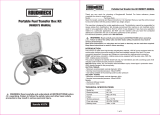
56L/MIN WALL MOUNTING DIESEL/FLUID
TRANSFER SYSTEM WITH METER
MODEL NO: TP955.V2
Thank you for purchasing a Sealey product. Manufactured to a high standard, this product will, if used according to these instructions,
and properly maintained, give you years of trouble free performance.
IMPORTANT: PLEASE READ THESE INSTRUCTIONS CAREFULLY. NOTE THE SAFE OPERATIONAL REQUIREMENTS, WARNINGS & CAUTIONS. USE
THE PRODUCT CORRECTLY AND WITH CARE FOR THE PURPOSE FOR WHICH IT IS INTENDED. FAILURE TO DO SO MAY CAUSE DAMAGE AND/OR
PERSONAL INJURY AND WILL INVALIDATE THE WARRANTY. KEEP THESE INSTRUCTIONS SAFE FOR FUTURE USE.
1. SAFETY
WARNING! It is the user’s responsibility to check the following:
Check all electrical equipment and appliances to ensure that they are safe before using. Inspect power supply leads, plugs and
all electrical connections for wear and damage. Sealey recommend that an RCD (Residual Current Device) is used with all electrical
products. You may obtain an RCD by contacting your local Sealey stockist.
If the product is used in the course of business duties, it must be maintained in a safe condition and routinely PAT (Portable
Appliance Test) tested.
Electrical safety information, it is important that the following information is read and understood.
Ensure that the insulation on all cables and on the appliance is safe before connecting it to the power supply.
Regularly inspect power supply cables and plugs for wear or damage and check all connections to ensure that they are secure.
Important: Ensure that the voltage rating on the appliance suits the power supply to be used and that the plug is tted with the
correct fuse - see fuse rating in these instructions.
8 DO NOT pull or carry the appliance by the power cable.
8 DO NOT pull the plug from the socket by the cable.
8 DO NOT use worn or damaged cables, plugs or connectors. Ensure that any faulty item is repaired or is
replaced immediately by a qualied electrician.
If the cable or plug is damaged during use, switch o the electricity supply and remove from use.
Ensure that repairs are carried out by a qualied electrician.
Replace a damaged plug with a BS1363/A 13 Amp 3 pin plug. If in doubt contact a qualied electrician.
a) Connect the GREEN/YELLOW earth wire to the earth terminal ‘E’.
b) Connect the BROWN live wire to the live terminal ‘L’.
c) Connect the BLUE neutral wire to the neutral terminal ‘N’.
Ensure that the cable outer sheath extends inside the cable restraint and that the restraint is tight.
Sealey recommend that repairs are carried out by a qualied electrician.
1.1. GENERAL SAFETY
WARNING! Ensure Health & Safety, government and local authority regulations relating to the transfer of
diesel are adhered to when using this equipment. Familiarise yourself with the application, limitations and specific hazards peculiar to the
pump.
WARNING! Disconnect pump from the mains power before changing accessories, servicing or performing any maintenance.
▲ DANGER: DO NOT use pump for the transfer of fluid other than diesel fuel of a viscosity from 2 to 5.35 cSt at 37.8OC, with a minimum
flash point (PM) of >55OC, or for any other purpose.
▲ DANGER: Motor is not explosion proof and must not be used where flammable vapours may be present.
WARNING! On first use or after running out of fuel perform the following:
Switch on power and squeeze and release the trigger to attempt to discharge fuel for max. 2 minutes. If no fuel flows remove
nozzle from dispensing hose and run pump again for max. 2 mins. DO NOT allow pump to run for more than 2 minutes if no fuel
flows out - refer to instruction manual. RUNNING PUMP WITH NO FUEL FLOW FOR OVER MINS. CAUSES INTERNAL DAMAGE.
9 Filters (if fitted) should be changed regularly to ensure unrestricted fuel flow.
9 Maintain pump in good condition (use authorised service agent). Drain meter and pipes before dismantling.
9 Ensure unit is correctly calibrated before use, and after having been dismantling for maintenance.
9 Maintain correct balance and footing. Ensure the floor is not slippery and wear non-slip shoes.
9 Ensure the transfer area is free of clutter and has adequate lighting.
9 The motor is equipped with a thermal cut-out which will shut the motor off should the unit over heat. If this happens, turn the unit off and
allow to cool, by which time the cut-out will automatically reset.
9 Keep children and unauthorised persons away from the working area.
9 Replace/repair damaged parts. Use genuine parts. Unauthorised parts are dangerous and will invalidate warranty.
9 Installation site must protect the unit from the weather.
9 Retain manual with the unit for reference for any new user.
8 DO NOT use the pump without the delivery nozzle attached.
8 DO NOT start or stop the pump by switching on or off at the mains power supply.
8 DO NOT use to dispense: petrol, inflammable liquieds, water, food liquids, liquids with viscosity>20 cSt, corrosive chemical products,
solvents.
8 DO NOT operate the unit with wet hands. We recommend the use of diesel resistant gloves and goggles.
Refer to
instruction
manual
Wear
protective
gloves
Wear protective
clothing
TP955.V2 Issue:2 (H,F) 12/10/21
Original Language Version
© Jack Sealey Limited
Recommended fuse rating
13 Amp
Wear
eye
protection









